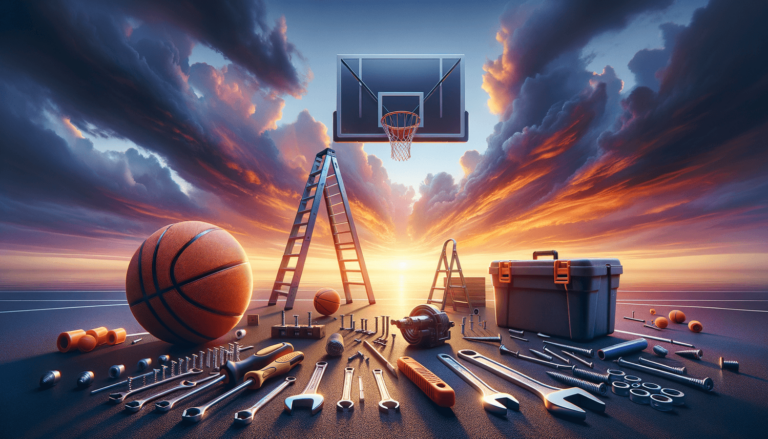
Have you ever dreamt of sinking the perfect three-pointer right in your own backyard, or heard the echoes of “slam dunk” reverberating through your home driveway? Installing a basketball hoop is the ideal solution to bring that exhilarating experience right to your doorstep! In this blog post, we’ll bounce into the realm of hoop installation, exploring the costs and factors that come into play when deciding the perfect setup for you. So lace up those sneakers, prepare your game face, and let’s jump into everything you need to know about basketball hoop installation. Swish!
How Much to Install Basketball Hoop?
The cost to install a basketball hoop can vary widely based on factors such as the type of hoop (in-ground, wall-mounted, or portable), materials, labor, and additional features. Generally, you can expect to spend between $300 and $1,500 for the hoop and installation. In-ground hoops are typically the most expensive, ranging from $400 to $1,500, while portable and wall-mounted options are more affordable at around $300 to $800. Keep in mind that these figures might increase if you require professional installation or choose to add accessories like lighting or padding.
Finding Your Hoop Sweet Spot: Types of Basketball Hoops and Their Costs
Understanding the different types of basketball hoops available and the associated costs is integral to making an informed decision. Here’s a breakdown of the most common hoop styles to help you find your groove:
In-ground Basketball Hoops
In-ground hoops offer a stable and durable option for serious hoops enthusiasts. These systems are cemented firmly into the ground, providing optimal support and an unparalleled playing experience. They’re ideal for more competitive games, lasting through countless layups, free throws, and dunks. They typically start at around $400 and can cost upwards of $1,500 for professional-grade systems.
Portable Basketball Hoops
Portable basketball hoops provide an adjustable and easily relocatable option for casual players and families. These systems come complete with a base filled with sand or water, which keeps the hoop sturdy while still allowing for movement as needed. Portable hoops range in price from $200 to $800, with premium models boasting added features such as backboards made from higher-quality materials or better-designed bases for added stability.
Wall-mounted Basketball Hoops
If saving space and maintaining flexibility are your top priorities, wall-mounted basketball hoops might be the ideal solution. These systems affix directly to a wall, garage, or other vertical surfaces, making them a perfect addition to smaller spaces. Wall-mounted hoops generally cost between $100 and $600, depending on the material, size, and features included in the design.
Installation and Labor Costs: Factoring in Professional Help
Whether you choose a DIY approach or enlist the help of professionals, installation labor is an important factor when budgeting for a basketball hoop installation. Depending on your hoop choice and individual needs, installation costs can differ:
In-ground Hoop Installation
Installing an in-ground basketball hoop is typically the most labor-intensive option, often requiring professional assistance. Digging a hole, pouring concrete, and accurately setting the pole can be challenging tasks for the inexperienced installer. Professional installation often runs between $400 and $1,000, depending on your location and the complexity of the project.
Portable Hoop Installation
Portable basketball hoops are perhaps the simplest and most cost-effective option to set up. The ease of assembly means most savvy DIY enthusiasts can efficiently handle the process. In some cases, you may opt for professional assembly or installation, which can cost you around $200 to $300. However, the majority of users can successfully assemble portable hoops without hiring professional help.
Wall-mounted Hoop Installation
While not as labor-intensive as in-ground systems, wall-mounted hoops may still require some expertise to install accurately and securely. The cost of professional installation for wall-mounted hoops ranges from $200 to $400, depending on the structure you need to mount it on and the complexity of the job. Consider any structural modifications that may be needed for secure installation when budgeting for this type of hoop.
Accessorizing and Upgrading: Go Big or Go Home
Once you’ve chosen your ideal basketball hoop, why not consider some accessories and upgrades to enhance the playing experience for everyone involved? Here are some popular add-ons and their price points to help elevate your home court to new heights:
Backboard Material
Not all backboards are created equal, and selecting the right material can greatly improve your basketball experience. Cheaper backboards often rely on materials like acrylic or polycarbonate, which can lead to a less authentic game experience. Alternatively, tempered glass backboards provide a professional-quality bounce with a more satisfying feel during play. Upgrading to a tempered glass backboard can set you back anywhere from $300 to $600, depending on the size and brand.
Protective Padding
Safety is essential when it comes to any sporting equipment, and basketball hoops are no exception. Adding padding to your hoop’s pole, base, and backboard can protect players from injury during intense games. This extra protection typically costs between $100 and $400, depending on the quality and coverage of the padding.
Lighting Solutions
Does playing after the sun goes down sound like the perfect way to unwind after a long day? Consider adding lighting to your basketball court! There are several options available for illuminating your hoop, ranging from floodlights to battery-powered LED solutions. Plan on spending anywhere between $50 and $300 to brighten up your basketball experience.
Adjustable Hoop Height
For younger players or those learning the game, adjustable hoop heights can be particularly beneficial. Most portable hoops offer an adjustable height feature, but it’s also possible to find in-ground systems that allow for height changes. Some wall-mounted hoops even have adjustable brackets available at an additional cost. While most adjustable hoops don’t require a significant budget increase, be sure to take this feature into consideration when choosing your ideal system.
Permits and Regulations: Make Sure You’re Above Board
Before you shoot those hoops, it’s crucial to check local regulations and permitting requirements for basketball hoops in your area. Adhering to these regulations not only keeps you on good terms with your community but also ensures a safe playing environment for everyone involved. Here are some factors to consider:
Local Building Codes and HOA Guidelines
Your town or city may have specific building codes and regulations that dictate where you can install your basketball hoop. Likewise, if you’re part of a Homeowners Association (HOA), they could have rules governing the placement and appearance of basketball hoops. Always check these guidelines before committing to your purchase, as violating rules and regulations can result in fines or forced removal of your hoop.
Acquiring Permits
Depending on local law, you may need a building permit to install an in-ground or wall-mounted basketball hoop. Be sure to verify if a permit is necessary and obtain one if needed. Permit costs can vary, but securing the right documentation can prevent fines or forced removal of your hoop – both of which can be expensive and emotionally draining experiences.
Maintaining Your Hoop for the Long Run: Be Proactive!
Once your hoop installation is complete, proper maintenance is essential for ensuring a long-lasting investment. Time, use, and weather can all take a toll on your hoop, but staying proactive can keep your home court in prime condition for years to come:
Outdoor Covers
Using outdoor covers for your basketball hoop can protect it from the elements, such as rain, snow, and UV damage. Covers typically cost between $30 and $100, varying based on size, material, and brand.
Rustproofing Treatments
Applying rustproofing treatments to your hoop’s metal components can help minimize wear and tear over time. These treatments generally cost between $20 and $50, making it a relatively affordable way to extend the life of your basketball hoop.
Regular Inspections and Tightening
Regular check-ups and maintenance can greatly contribute to the longevity of your hoop. Make a point to inspect and tighten bolts, nuts, and other connections periodically to prevent any surprises during gameplay.
Base Maintenance
If you opted for a portable hoop, monitor the water or sand levels in the base and refill as needed to maintain stability. In freezing conditions, be sure to drain your base to avoid damage caused by expanding water.
The Ultimate Gift: Investing in the Basketball Experience
Investing in a basketball hoop for your home is an investment in not only the sport itself but also the joy and enrichment it can bring to your life. From forging friendships and fostering family connections to staying active and improving your skills, a basketball hoop can provide countless benefits on and off the court. By understanding the ins and outs of hoop installation costs and factors, you can make an educated decision that promises to unite the love of basketball with the comforts of home.
Factors to Consider for the Perfect Hoop Setup: Location and Budget
To make the most of your basketball hoop installation, it’s essential to evaluate the space at your disposal and the financial resources you have available. With these factors in mind, you can tailor your hoop setup to meet your basketball dreams without breaking the bank:
Size Matters: Assessing Your Space
Before selecting a basketball hoop system, evaluate the available space where you plan on installing it. Keep in mind the minimum dimensions required for a proper playing experience: a court typically measures 50 feet long by 30 feet wide at the recreational level, but a half-court setup (30 feet by 30 feet) may suffice. Also, consider your playing surface – you’ll want a smooth, flat area that provides good traction for players.
Setting a Budget: Know Your Limits
With a wide range of basketball hoop options available, it’s crucial to establish a budget before diving into the selection process. Factor in the cost of the hoop system itself, installation labor, potential permits, and any desired accessories or upgrades. This will give you a clear understanding of what you can afford and help to narrow down your choices to those within your financial means.
Choosing a Brand and Model: Deciding on Quality and Features
Once you’ve determined your available space and budget, it’s time to decide on the brand and model that will best meet your needs. Here’s a closer look at what to consider when selecting the ideal basketball hoop for your home:
Top Basketball Hoop Brands and Their Offerings
There are several manufacturers that produce high-quality basketball hoops, each offering its unique blend of features, prices, and performance:
- Goalrilla: Known for their robust in-ground basketball hoops, Goalrilla offers systems with durable support, steel frames, and tempered glass backboards.
- Spalding: As the official provider of NBA basketballs, Spalding delivers a wide range of hoop options, from in-ground to portable systems, catering to all levels of play.
- Lifetime: With a focus on affordability, Lifetime provides a selection of portable and in-ground hoops, along with accessories and customizable options.
- Silverback: A subdivision of Goalrilla, Silverback delivers sleek, sturdy, and versatile in-ground and wall-mounted systems along with portable hoops that cater to serious players and families alike.
Comparing Models: Key Features and Specifications
As you evaluate different basketball hoop options, it’s important to consider specific features and specifications that will impact your playing experience, including:
- Backboard Size and Material: The size of the backboard affects the space needed for installation, while the material can alter the ball’s rebound effect. Consider the ideal combination of size and material for your court and skill level.
- Support Pole Size and Design: A hoop’s support pole plays a vital role in providing stability and rigidity, with thicker poles offering greater durability. Research the support pole construction and design to ensure it will hold up over time and under pressure.
- Adjustable Height Mechanism: If varying the hoop’s height is essential for your playing needs, study the height adjustment mechanisms of each model. Some systems have easier and more precise adjusting systems than others, making it more convenient to accommodate players of different ages and skill levels.
- Anchor or Base System: Investigate the anchor or base system used by each basketball hoop and consider its compatibility with your installation location. In-ground hoops require concrete foundations, while portable systems rely on water or sand-filled bases.
- Assembly and Installation Process: When browsing different basketball hoops, pay attention to the assembly and installation process. Some manufacturers include assembly guides and online resources to simplify the installation, while others may necessitate professional help.
By thoroughly researching various basketball hoop brands, models, and features, along with considering factors such as available space and budget, you’ll be equipped to make an informed decision for a tailor-made basketball experience. Remember, the goal is to find the hoop setup that best aligns with your individual preferences and requirements. So, shoot for the stars, and soon you’ll be dribbling, passing, and scoring in your very own home court!
Frequently Asked Questions: All About Basketball Hoop Installation
To help you find the answers you’re looking for regarding basketball hoop installation, we’ve compiled a list of common questions along with concise, informative responses. Explore these FAQ’s to clarify any uncertainties and make the best decision for your at-home basketball experience:
1. How much space do I need to install a basketball hoop?
A standard full-court measures 94 by 50 feet, but for home courts, you can opt for a half-court setup, measuring about 30 by 30 feet. Consider the playing surface as well – it should be smooth, flat, and provide adequate traction for players to avoid injuries.
2. Can I install a basketball hoop without professional assistance?
While it’s possible to install a basketball hoop without professional help, the feasibility depends on the type of hoop and your skills. Portable hoops are generally easy to assemble, whereas in-ground systems might require the expertise of a professional for tasks like mixing and pouring concrete.
3. What factors determine the cost of basketball hoop installation?
Factors that will determine the cost of your basketball hoop installation include the type of hoop (in-ground, portable, or wall-mounted), the brand and model, materials used, labor cost for installation, and any additional features or accessories, such as padding or lighting.
4. Do I need a permit to install a basketball hoop?
Permit requirements vary based on your location and the type of basketball hoop you plan to install. Check with your local building department and homeowners association to ensure you get the necessary permits and adhere to any guidelines.
5. What type of backboard should I choose – acrylic, polycarbonate, or tempered glass?
Each backboard material offers unique characteristics: acrylic and polycarbonate provide durability at a lower price but may not replicate the professional “bounce” effect; tempered glass offers a premium experience, closely resembling a gym or NBA court. Your choice should depend on your desired playing experience and budget.
6. How do I maintain my basketball hoop for the long run?
To keep your basketball hoop in prime condition, consider using outdoor covers, rustproofing treatments, and regularly inspecting and tightening all bolts and connections. For portable hoops, monitor the water or sand in the base to maintain stability and prevent damage from freezing.
7. Is a wall-mounted basketball hoop a good choice for me?
Wall-mounted basketball hoops are an ideal option for those with limited space or budgets. They attach directly to a wall or other vertical surfaces, providing a stable and space-saving solution. Be sure to consider any required modifications to your mounting surface for secure installation.
8. What is the difference between portable and in-ground basketball hoops?
In-ground basketball hoops are cemented into the ground, offering a more stable and durable hoop, best-suited for serious players or competitive games. Portable hoops are easier to set up and move, making them a convenient choice for casual players and families.
9. Should I buy a basketball hoop with an adjustable height feature?
An adjustable height feature is advantageous if you have players of varying ages and skill levels, as it allows you to change the hoop height to accommodate their needs with minimal effort. This feature is especially useful for younger players learning the game.
10. Are there installation professionals that specialize in basketball hoops?
Yes, there are professionals who specialize in basketball hoop installations, and many companies provide these services. It’s crucial to hire experienced professionals for tasks like in-ground hoop installations to ensure the job is done accurately and safely.
11. What should I consider when choosing a basketball hoop brand and model?
When selecting a basketball hoop brand and model, consider factors like backboard material and size, support pole design, adjustable height mechanism, installation process, and anchor or base system. Align your preferences and requirements to find the perfect hoop for your needs.
12. How much do basketball hoop accessories typically cost?
Prices for basketball hoop accessories depend on the product type and quality. Upgrading to a tempered glass backboard might cost between $300 and $600, while other accessories like padding, lighting, or covers can range from $50 to $400.
13. How can I prevent my portable basketball hoop from tipping over?
To minimize the risk of your portable basketball hoop tipping over, ensure that the base is completely filled with sand or water. Regularly check the base’s content level and refill as needed to maintain the hoop’s stability. Utilize additional sandbags or weights on the base, if necessary, for extra support.
Featured Posts
- No pillar pages found.





